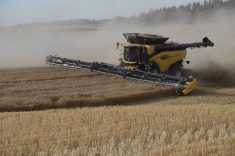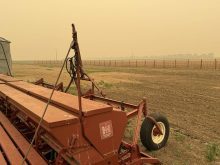Winter windbreaks for cattle used to consist of clumps of trees, a farm
site and permanent slab fences.
But livestock management and farmland ownership are changing, and so
are windbreaks.
Wayne Winchell, a livestock handling systems engineer with Alberta
Agriculture, says cattle “are moving out of the traditional pasture,
but their shelter needs remain.”
He said winter grazing this year is drawing cattle onto open prairie
that is “cleared for crops, not for cattle.”
Read Also

U.S. softens fees on Chinese shipping
The U.S. starts charging new fees on Chinese ships on Oct. 14. What are the ramifications for their ag exports?
Environmental concerns are also causing cattle to be moved away from
riparian areas that have traditionally contained bush and valley
shelters.
“Design is really important,” he said of portable windbreaks.
“Just being able to move it is one thing, but there are other
considerations.”
Most breaks are made of one by six or one by eight rough wood and are
bolted to steel frames.
Portable breaks must fit between fence openings or be built so they can
be safely lifted over a fence by a tractor with a front-end loader.
If long distance moves might be required, the panels should be capable
of being disassembled and placed on a trailer.
The sections must have feet large enough to keep them upright in a
wind, but should be sturdy enough to be removed from soil if they
become frozen down.
“There is nothing worse than a portable windbreak that becomes
permanent for the winter,” said Trevor Yurchak, a livestock agrologist
with Alberta Agriculture.
“It is often more efficient to bring the cattle to the feed and water
than the other way around and by moving them you improve manure
distribution.
Once calving starts, it can help keep disease in check, but give them
fresh ground every so often.”
Winchell said bedding should be kept three to four times the height of
the fence away from the fence on the leeward side.
“Snow builds up really well behind these fences and you want to bed out
beyond the snow bank.”
Windbreak panels should be designed to allow for 20 to 30 percent
porosity, and include a 15 centimetre gap at the bottom to prevent
plugging with snow or a build up of manure that will freeze the unit
down.
“Twenty or 30 percent (porosity) will get you 75 to 85 percent wind
reduction over an area 10 to 12 times the height of the break.”
He said some wedge designs that “cost more to build and are heavier”
can double as calf shelter.
“It doesn’t matter the design, and there are many, whether you build
yourself or buy it from a contractor,” Winchell said.
“The main thing to remember is wind pressure. It can be enormous so you
have to be sure that whatever brace you have is sturdy enough for your
wind conditions.”
















